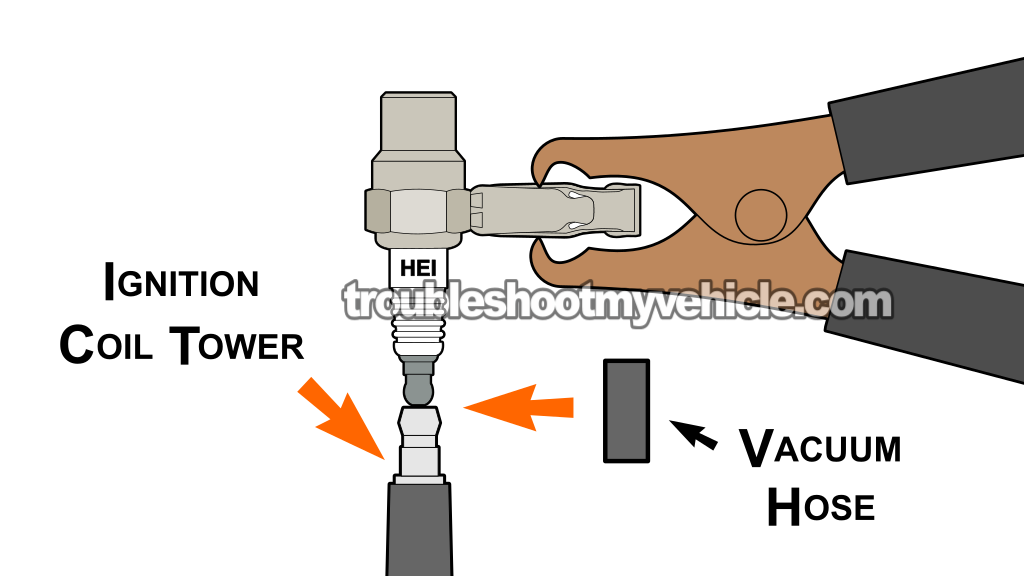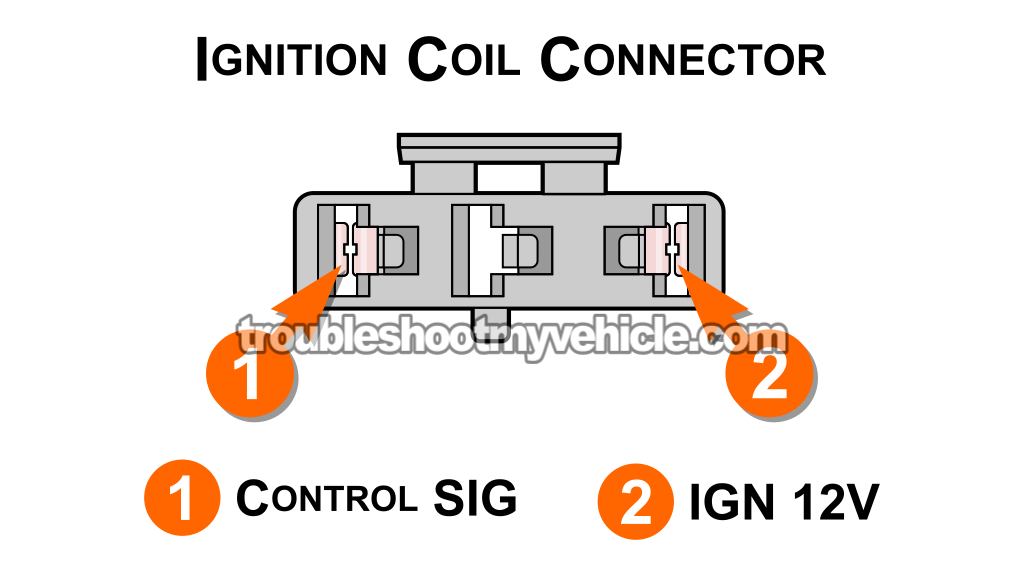TEST 4: Checking The Ignition Coil Tower For Spark

Up to this point, your ignition system tests have confirmed the following:
- None of the six spark plug wires are sparking (TEST 1).
- The ignition coil's high-tension wire isn't sparking (TEST 3).
For our next test, we're going to check for spark directly at the ignition coil's tower. If you look at the illustration above, you'll notice that you'll need to place your spark tester right on top of the ignition coil's metal terminal.
To keep the spark tester in place while cranking the engine, use a small piece of vacuum hose to attach the tester to the metal terminal on the ignition coil tower.
All right, let's get started:
- 1
Disconnect the high tension wire from the ignition coil tower.
- 2
Attach the HEI spark tester to the ignition coil tower using a small piece of vacuum hose (see the illustration above).
NOTE: The vacuum hose must be short enough so that both the HEI spark tester and the ignition coil tower can make metal to metal contact. - 3
Connect the HEI spark tester to the battery negative (-) terminal using a battery jump start cable.
- 4
Have your helper crank the engine while you observe the spark tester from a safe distance.
- 5
You'll get one of two results:
1.) The spark tester will spark.
2.) The spark tester will NOT spark.
Alright —let's see what your spark test result is telling us:
CASE 1: The spark tester sparked. This is the correct test result, and it confirms that the ignition coil itself is OK —also, that it's getting both power and its activation signal.
Now, since the ignition coil sparked, we can safely conclude that the high-tension wire connecting it to the distributor cap is fried. Replace all of the spark plug wires with a new set to fix your Ford Taurus or Mercury Sable's engine no-start issue.
CASE 2: The spark tester didn't spark. This no-spark result tells us we can rule out the ignition coil's high-tension wire as the cause of the no-spark readings in TEST 1 and TEST 3 —since the ignition coil itself isn't sparking.
To figure out why the ignition coil isn't sparking, we need to make sure it's getting power and an activation signal. For the first of these two checks, head over to: TEST 5: Making Sure The Ignition Coil Is Getting Power.
TEST 5: Making Sure The Ignition Coil Is Getting Power

Like any other electrical component on your Ford Taurus or Mercury Sable, the ignition coil needs power to function and produce spark.
In this test section, we're going to make sure the ignition coil's getting power —10 to 12 Volts— on the red with light green stripe (RED/LT GRN) wire of its two-wire connector.
This ignition voltage is available with the key in either the RUN or START position. For our test, we'll check that this voltage is present with the key in the RUN position and the engine OFF.
OK, let's begin:
- 1
Disconnect the ignition coil connector from the ignition coil.
- 2
Place your multimeter Volts DC mode.
- 3
Connect the black multimeter test lead to the battery negative (-) post.
- 4
Turn the key to the ON position but don't start the engine.
- 5
With the red multimeter test lead, probe female terminal 2 of the connector.
NOTE: Double-check that terminal 2 corresponds to the RED/LT GRN wire. - 6
Your multimeter should read 10 to 12 Volts DC.
Let's interpret your test result:
CASE 1: The RED/LT GRN wire is delivering 10 to 12 Volts. This is the result we wanted to see, and it tells us the ignition coil's getting the power it needs to produce spark.
Our next diagnostic step is to see if the ignition coil's receiving an activation signal from the ignition control module. For this test, go to: TEST 6: Making Sure The Ignition Coil Is Getting An Activation Signal.
CASE 2: The RED/LT GRN wire isn't delivering 10 to 12 Volts. Without this power, the ignition coil can't produce spark. This result rules out the ignition coil itself as the cause of the no-spark, no-start problem.
Although it's beyond the scope of this tutorial, your next step is to find out why the RED/LT GRN wire doesn't have 10 to 12 Volts with the key ON and restore power to the circuit. Once that voltage is present, the ignition coil should spark again and the engine should start.
TEST 6: Making Sure The Ignition Coil Is Getting An Activation Signal

So far, your ignition system tests have confirmed the following:
- No spark at all six spark plug wires (TEST 1).
- The ignition coil's high-tension wire isn't sparking (TEST 3).
- The ignition coil itself is sparking (TEST 4).
- The ignition coil's getting 10 to 12 Volts (TEST 5).
For our final diagnostic test, we're going to check if the ignition coil's receiving an activation signal to start sparking.
This activation signal is provided by your Ford Taurus or Mercury Sable's ignition control module (ICM) and delivered by the tan with yellow stripe (TAN/YEL) wire of the ignition coil's connector.
To check for the presence of this signal, we'll use a regular 12-Volt automotive test light —specifically an incandescent type. If you don't have one, this is the one I use myself and recommend, and you can buy it here: Lisle 28400 Heavy Duty 12 Volt Test Light (Amazon affiliate link).
Alright, let's get to work:
- 1
Disconnect the ignition coil from its electrical connector.
- 2
Connect the test light's crocodile clip to the battery positive (+) terminal.
- 3
With the metal point of the 12 Volt test light, back-probe terminal 1 of the connector.
The TAN/YEL wire connects to terminal 1 of the connector (see the connector pinout illustration above) and connects directly to the ignition control module. - 4
Have your helper crank the engine while you observe the 12 Volt test light.
- 5
You'll see one of two things:
1.) The 12 Volt test light flashes ON and OFF.
2.) The 12 Volt test light DOES NOT flash ON and OFF.
NOTE: Don't worry about what the test light does before cranking the engine. What matters is whether the test light flashes ON and OFF while the engine's being cranked.
Let's walk through what this result indicates:
CASE 1: The test light flashed ON and OFF. This confirms the ignition control module is actively trying to get the ignition coil to spark.
With this test result, you can confidently conclude the ignition coil is fried —as long as you've already checked and confirmed the following:
- TEST 1: No spark at all six spark plug wires.
- TEST 3: The ignition coil's high-tension wire isn't sparking.
- TEST 4: The ignition coil itself is sparking.
- TEST 5: The ignition coil's getting 10 to 12 Volts.
CASE 2: The 12V test light did not flash ON and OFF while cranking the engine. With this result, we can rule out the ignition coil itself as the cause of the no-spark, no-start problem you're troubleshooting —without this activation signal from the ignition control module, the coil won't spark.
The most likely cause of the missing activation signal is either a bad ignition control module or a failed crankshaft position (CKP) sensor.
Your next step is to check the ignition control module, and the tutorial below will walk you through it step by step: How To Test The Ignition Control Module (1990-1995 3.8L V6 Ford Taurus, Mercury Sable).
More 3.8L V6 Ford Taurus Diagnostic Tutorials
You can find a complete list of diagnostics tutorials for the 3.8L V6 Taurus and Mercury Sable in this index:
Here's a small sample of the tutorials you'll find in the index:
- How To Test The TPS With A Multimeter (1990-1995 3.8L V6 Taurus, Mercury Sable).
- How To Test The Fuel Pump (1990-1995 3.8L V6 Ford Taurus, Mercury Sable).
- How To Test The MAF Sensor (1991-1995 3.8L V6 Ford Taurus, Mercury Sable).
- How To Test For A Blown Head Gasket (1990-1995 3.8L V6 Ford Taurus, Mercury Sable).

If this info saved the day, buy me a beer!

